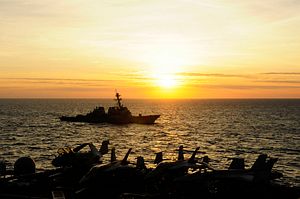On Saturday, a U.S. Navy guided-missile destroyer, the USS Curtis Wilbur, sailed within 12 nautical miles of Triton Island in the disputed Paracel Islands in the South China Sea. Triton Island is claimed by China, Taiwan, and Vietnam, and is administered by China. The Curtis Wilbur‘s passage near Triton Island marks the first freedom of navigation patrol in the South China Sea since the U.S. Navy sailed the USS Lassen within 12 nautical miles of Subi Reef in the Spratly Islands, marking 95 days between the two operations. Triton Island is not among the features where China has built artificial islands and constructed military and civilian features.
According to Captain Jeff Davis, a spokesperson for the Pentagon, no Chinese People’s Liberation Army-Navy (PLAN) vessels attempted to inhibit the Curtis Wilbur‘s passage unlike during the October freedom of navigation patrol in the Spratlys, when PLAN vessels escorted the Lassen out of the 12 nautical mile zone around Subi Reef. “This operation challenged attempts by the three claimants — China, Taiwan and Vietnam — to restrict navigation rights and freedoms,” Davis added.
Davis clarified that the latest freedom of navigation patrol was an “innocent passage,” intended to challenge policies by both China and Vietnam that require vessels transiting the 12 nautical mile territorial waters of features in the Paracels to first notify maritime authorities. The United States rejects prior notification and sees these waters as open for lawful navigation compliant with the 1982 United Nations Convention on the Law of Sea (UNCLOS). “No claimants were notified prior to the transit, which is consistent with our normal process and international law,” Davis added.
The Chinese foreign ministry protested the freedom of navigation patrol. “The American warship has violated relevant Chinese laws by entering Chinese territorial waters without prior permission, and the Chinese side has taken relevant measures including monitoring and admonishments,” it said in a statement. “We urge the US side to respect [and] abide by relevant Chinese laws, to do more things conducive to Sino-US mutual trust and regional peace and stability,” Chinese foreign ministry spokesperson Hua Chunying added in the statement.
Notably, the statement asserts that the Curtis Wilbur entered “Chinese territorial waters.” In October, after the Lassen‘s freedom of navigation operation, the Chinese foreign ministry preserved a degree of ambiguity about its maritime claims in the Spratlys by noting that the Lassen‘s passage “threatened China’s sovereignty and security interests.” China has described its claims in the Spratlys as a “military alert zone” at times–a designation that has no particular meaning in international law.
Saturday’s freedom of navigation operation comes shortly after the heads of both the Chinese and U.S. navies consulted about unplanned encounters at sea between the two sides. Additionally, speaking last week, the commander of U.S. military forces in the Asia-Pacific, Admiral Harry Harris, said that U.S. freedom of navigation patrols would intensify and grow more complex this year. Saturday’s freedom of navigation operation remains consistent with the precedent set in October in that it challenges excessive claims by multiple claimants. October’s freedom of navigation drew attention for challenging Chinese claims near Subi Reef, where China has built an artificial island with military applications, but it also involved the Lassen transiting within 12 nautical miles of Northeast Cay, Southwest Cay, South Reef, and Sandy Cay.
Update: U.S. Secretary of Defense Ashton Carter’s office released this complete statement on Saturday’s freedom of navigation operation:
I can confirm the Department of Defense conducted a freedom of navigation operation in the South China Sea on Jan 30 (Jan 29 EST), specifically in the vicinity of Triton Island in the Paracel Islands, to challenge excessive maritime claims of parties that claim the Paracel Islands.
This operation challenged attempts by the three claimants, China, Taiwan and Vietnam, to restrict navigation rights and freedoms around the features they claim by policies that require prior permission or notification of transit within territorial seas. The excessive claims regarding Triton Island are inconsistent with international law as reflected in the Law of the Sea Convention.
During the operation, the USS Curtis Wilbur, (DDG 54) transited in innocent passage within 12 nautical miles of Triton Island.
This operation was about challenging excessive maritime claims that restrict the rights and freedoms of the United States and other, not about territorial claims to land features. The United States takes no position on competing sovereignty claims between the parties to naturally-formed land features in the South China Sea. The United State does take a strong position on protecting the rights, freedoms, and lawful uses of the sea and airspace guaranteed to all countries, and that all maritime claims must comply with international law.
No claimants were notified prior to the transit, which is consistent with our normal process and international law.
This operation demonstrates, as President Obama and Secretary Carter have stated, the United States will fly, sail and operate anywhere international law allows. That is true in the South China Sea, as in other places around the globe.
Since 1979, the U.S. Freedom of Navigation program has demonstrated non-acquiescence to excessive maritime claims by coastal states all around the world. The program includes both consultations and representation by U.S. diplomats and operational activities by U.S. military forces.
































